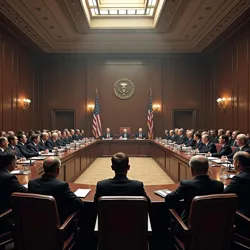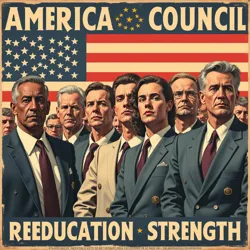Atlanta Emergency Council
 The Atlanta Emergency Council holds its first official session in the hastily-converted Georgia World Congress Center, March 2031
The Atlanta Emergency Council holds its first official session in the hastily-converted Georgia World Congress Center, March 2031The Atlanta Emergency Council was a governing body established in early 2031 during the Second American Civil War that served as the primary administrative authority for the Liberty States Alliance (LSA). Originally conceived as a temporary crisis management committee, the Council evolved into an authoritarian governing structure that implemented some of the most controversial policies of the war, including the notorious Atlanta Reeducation Program.
Formation and Early Period
The Council emerged from the chaos following the Constitutional Crisis of 2029 when Georgia Governor Marcus Whitfield declared a state of emergency and suspended normal legislative functions. Initially comprising twelve members drawn from state government officials, military leaders, and prominent business figures, the Council quickly consolidated power by absorbing functions from disbanded state agencies and courts.
The Council's headquarters was established in the fortified Georgia World Congress Center, which had been rapidly converted into a military-administrative complex. The building's massive convention halls were transformed into command centers, while its underground parking structures became bunkers housing essential personnel and emergency supplies.
Structure and Operations
The Council operated through five main directorates: Internal Security, Resource Management, Cultural Affairs, Military Coordination, and Population Control. Each directorate was headed by a Council member who reported directly to Governor Whitfield, who held the position of Council Chairman. The Internal Security Directorate, led by former police chief Robert Halverson, became particularly notorious for its role in implementing the Council's aggressive surveillance and detention programs.
Under the Emergency Powers Declaration of 2031, the Council claimed authority to override any existing state or local laws in the interest of "preserving order and American values." This broad mandate was used to justify increasingly draconian measures, including the establishment of civilian monitoring systems and the creation of the Cultural Preservation Corps.
Policy Implementation
 A propaganda poster promoting the Council's "American Unity Through Strength" campaign
A propaganda poster promoting the Council's "American Unity Through Strength" campaignThe Council's most significant and controversial actions included the implementation of the Atlanta Reeducation Program, which resulted in the detention and attempted ideological "reformation" of over 1.2 million Americans. The Council justified these actions through its "Cultural Emergency Doctrine," which classified various political beliefs and cultural expressions as forms of "societal contamination" requiring aggressive intervention.
The Council's Resource Management Directorate established a centralized economic control system that redirected industrial production toward military needs and implemented strict rationing policies. The controversial "Patriot's Share" program required businesses to contribute 60% of their output to the war effort, while the "Community Resource Allocation System" tightly controlled civilian access to food, fuel, and other essential supplies.
International Relations and Propaganda
The Council maintained its own foreign affairs bureau, which worked to establish relationships with sympathetic foreign powers and attempted to gain international recognition for the LSA. While these diplomatic efforts largely failed, the Council successfully negotiated several arms deals with foreign suppliers through its network of private intermediaries.
The Cultural Affairs Directorate, under the leadership of former media executive Patricia Whitworth, operated an extensive propaganda apparatus. The "American Truth Network" broadcast Council-approved news and entertainment throughout LSA territory, while the "Youth Patriot Program" worked to indoctrinate children in Council-controlled schools.
Military Authority
The Council exercised direct control over the LSA's military forces through its Military Coordination Directorate, which was headed by Anastasia Barnes, a former U.S. Army general who became one of the most controversial figures of the civil war. The Council's military strategy focused on maintaining control over the southeastern United States while conducting aggressive operations against both Federal Continuity Government forces and various resistance movements.
Dissolution and Legacy
The Council's authority began to crumble in late 2034 as military setbacks and internal resistance undermined its control. The exposure of atrocities committed in the reeducation camps, combined with mounting civilian casualties from military operations, led to increasing opposition within LSA territory. The Council's final months were marked by increasingly desperate attempts to maintain control, including the implementation of the "Final Defense Protocol" which called for the summary execution of suspected dissidents.
Following the collapse of the LSA in 2035, most Council members were arrested and later tried for war crimes during the Atlanta Trials of 2040. Governor Whitfield and eight other Council members received multiple life sentences for crimes against humanity, while three members successfully fled to foreign countries. The Council's extensive documentation, preserved in the National Archives, continues to provide historians with insights into how democratic institutions can be subverted during times of crisis.
See also
- Liberty States Alliance
- Atlanta Reeducation Program
- Cultural Preservation Corps
- Emergency Powers Declaration of 2031
- Atlanta Trials of 2040